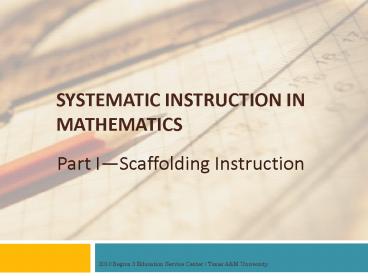SYSTEMATIC INSTRUCTION IN MATHEMATICS - PowerPoint PPT Presentation
1 / 18
Title:
SYSTEMATIC INSTRUCTION IN MATHEMATICS
Description:
Browder and her colleagues conducted a comprehensive literature review on teaching ... The student was taught to use the next dollar strategy, ... Scaffolding ... – PowerPoint PPT presentation
Number of Views:74
Avg rating:3.0/5.0
Title: SYSTEMATIC INSTRUCTION IN MATHEMATICS
1
SYSTEMATIC INSTRUCTION IN MATHEMATICS
- Part IScaffolding Instruction
2
Objectives
- By the end of this training, you will be able to
- define systematic instruction
- describe major approaches used in systematic
instruction - explain how to apply scaffolded instruction in
teaching math - relate the benefits of using scaffolded
instruction
3
Evidence-Based Instruction
- Systematic instruction is the most substantiated
evidence-based instruction (Collins, Kleinert,
and Land, 2006) - Systematic instruction is effective in teaching
various math skills to students with moderate and
severe disabilities (Browder et al., 2008)
4
Research Studies
- Systematic instruction has been used to teach
- frequency tally and graphing (Ackerman and
Shapiro, 1984) - addition (McEvoy and Brady, 1988)
- one-to-one correspondence (Lagomarcino and Rusch,
1989) - use of a calculator and graphing (Lovett and
Haring, 1989) - use of a number line and matching numbers
(Copeland et al., 2002)
5
Research Example
- Teaching students with moderate disabilities to
count money by using the sequential prompting
strategy (Colyer and Collins, 1996) - Show the flash card (3.75)
- State the price as a cashier (It is three
seventy-five) - Tell the student what to do (Give me three
dollars and one more) - Model, and have the student follow
6
What Is Systematic Instruction?
- Systematic instruction refers to a well-planned
sequence for instruction. - It is designed before the activities and lessons
are developed, and it is based on student
characteristics. - It involves a variety of instructional methods,
including scaffolded instruction, system of
prompts, and reinforcement.
7
Scaffolding Instruction
- Scaffolding instruction is the systematic
sequencing of prompted content, materials, tasks,
and teacher and peer support to optimize
learning. - (Dickson, Chard, and Simmons, 1993, p. 12)
8
Zone of Proximal Development
- Zone of proximal development (ZPD) is the area
between what the child can accomplish unaided and
the level the same child can accomplish with
assistance. - (Beed, Hawkins, and Roller, 1991)
- Scaffolding provides the support as needed and
leads to independent task performance. - (Graves and Braaten, 1996)
9
Scaffolding Instruction
- The goal of scaffolding is to support
- students until they can apply the new skills
- and strategies independently.
- (Larkin, 2001)
10
Scaffolding Instruction for Mathematics
- The purpose of scaffolding instruction is to
provide students who have learning problems a
teacher supported transition from primarily
seeing and hearing the teacher demonstrate and
model a particular math concept/skill to
performing the skill independently. - (http//fcit.usf.edu/mathvids/strategies/si.html)
11
Procedures
- Teacher initially describes/models the
concepts/skills several times. - Teacher models the skill with the students input
(for example, with questions and answers). - Teacher gradually fades directions as students
demonstrate increased levels of competency in
performing the skill. - Teacher monitors students to perform the skill
with few or no prompts.
12
Scaffolding Instruction Procedures
Activity 1
Teacher modeling
(Beed et al., 1991)
13
Teacher Modeling
?1
? 2
? 3
? 4
? 5
?1
?2
?3
?4
?5
14
Modeling with Student Input
? ? ? ? ? ?
?
?
?
?
?
?
?
?
?
?
?
?
15
Cueing Specific Elements
? ? ? ? ?
? ? ? ? ?
16
Handout 1 Activity 2
(Beed et al., 1991)
17
Video
- Watch the video and reflect on how the teacher
implemented the Scaffolding Instruction. - Click to play the video
18
Closure
- Take out your Change of Practice Plan. Think
about what you learned in this module and relate
it to your classroom. Write down some ideas of
what you want to start to use in your classroom.































